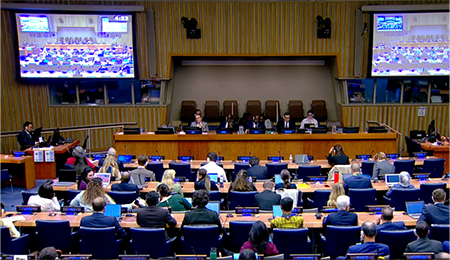"I want to tell you that your fact sheet on the [Missile Technology Control Regime] is very well done and useful for me when I have to speak on MTCR issues."
Divisions Among Nuclear States Mar NPT Meeting
June 2025
By Sizuka Kuramitsu, Lipi Shetty, and Daryl G. Kimball
The third and final preparatory committee meeting ahead of the 2026 nuclear Nonproliferation Treaty (NPT) Review Conference ended May 9 with little room for optimism for agreement on a consensus outcome document next year.

The review process is designed to bring together the 191 NPT states-parties to formally review compliance with and implementation of the treaty’s three pillars of disarmament, nonproliferation, and peaceful uses of nuclear energy.
According to diplomatic sources who spoke with Arms Control Today, the two-week-long preparatory meeting came close to consensus on a draft package of proposals for strengthening the review process, but disputes among some NPT nuclear-armed states, including China, emerged on the final day.
The impasse over strengthening the review process scuttled any further efforts to reach an agreement on a separate draft package of substantive recommendations for the Review Conference, which the president of the meeting, Harold Agyeman of Ghana, circulated for consideration.
In his opening statement, Agyeman emphasized that the NPT is under stress. “Today, we stand at a crossroads, and the credibility of the treaty, which for 50 [years] has served as the cornerstone of global non-proliferation and nuclear disarmament efforts, is challenged, within a context where predictability is required more than ever,” he said April 28.
“As we therefore complete the final lap towards the 2026 Review Conference, my appeal to states-parties is simple. Time is running out on us and we must be ready to see the bigger picture, to put aside our national differences and work collectively towards the goal of a world free of nuclear weapons that preserves the human civilisation.”
Although the vast majority of states did seek to find common ground, differences among the NPT’s nuclear-armed states continued to dog the discussions and stymie progress.
During the two week preparatory committee meeting, states-parties voiced various concerns about existing and emerging threats to the treaty, including the impact of Russia’s full-scale invasion of Ukraine on the global nuclear order; China’s nuclear weapons build-up; the forward deployment of U.S. tactical nuclear weapons in Europe; Russian nuclear weapons in Belarus; threats to the global nuclear test moratorium; and the failure of the five NPT nuclear-armed states to engage in negotiations on disarmament, which is a central obligation under
Article VI of the treaty.
As states agreed at the 2000 Review Conference, the third preparatory committee should take stock of the two previous preparatory committee meetings and “make every effort to produce a consensus report containing recommendations” for the following year’s review conference. But as was the case in the past, the states-parties could not produce substantive recommendations for the next year’s conference by consensus.
As at previous preparatory committee meetings, a group of 48 states issued a joint statement to condemn Russia’s war against Ukraine including the occupation of the Zaporizhzhia nuclear power plant and nuclear sharing with Belarus. “We condemn in the strongest possible terms Russia’s irresponsible and threatening nuclear rhetoric as well as its posture of strategic intimidation, including its announced deployment of nuclear weapons in Belarus,” read the joint statement.
In keeping with recent U.S. abstentions in other fora on the subject since the inauguration of President Donald Trump, the United States did not join the statement condemning Russia.
The United States, represented by a less senior delegation than in years past, reiterated Trump’s statements expressing a readiness to talk with China and Russia on “denuclearization.” The statements also sought to contrast the U.S. record on its relative transparency regarding its nuclear arsenals and nuclear posture with that of China.
Referring to Trump, Paul Watzlavick, the recently appointed head of the U.S. delegation, said April 29: “He has made clear his desire to address the threat posed by Russia and China’s nuclear arsenals.”
“In sharp contrast to China’s opaque nuclear weapons build-up, the United States has been remarkably transparent, releasing the number of weapons in our stockpile twice in the last four years. However, for too long U.S. leadership and transparency have not been met with reciprocity by China and Russia,” Watzlavick said.
The closing session on May 9 opened with several joint statements, including one delivered by Ireland on behalf of 49 states-parties on the importance of strengthening transparency and accountability measures.
Referring to the fast approaching expiration of the last remaining treaty limiting the Russian and U.S. nuclear arsenals, the New Strategic Arms Reduction Treaty (New START), Austria also took to the floor to deliver a joint statement on behalf of 24 states calling on the United States and Russia to re-engage on nuclear disarmament and to refrain from increasing the size of their deployed strategic arsenals after New START expires on Feb. 6, 2026.
Underscoring the importance of disarmament under current high tensions, it is “urgent to preserve and achieve further reduction and limitations of deployed strategic nuclear arsenals,” the joint statement said.
It also called “for the urgent commencement of negotiations for a successor agreement and … for a return to full and mutual compliance with the limits set by the treaty until such time as a successor pact is concluded in order to secure the achievements of the New START Treaty before its expiry and to achieve further progress on the limits on and reduction of deployed strategic nuclear arsenals.”
The 2026 NPT Review Conference is set for April 27 to May 22 in New York and will be chaired by Vietnam. The last time an NPT review conference adopted a substantive outcome document by consensus was in 2010.
